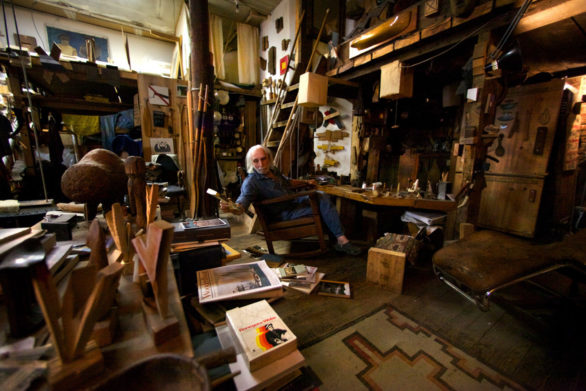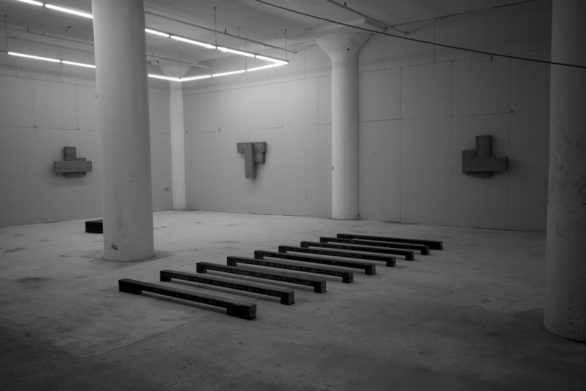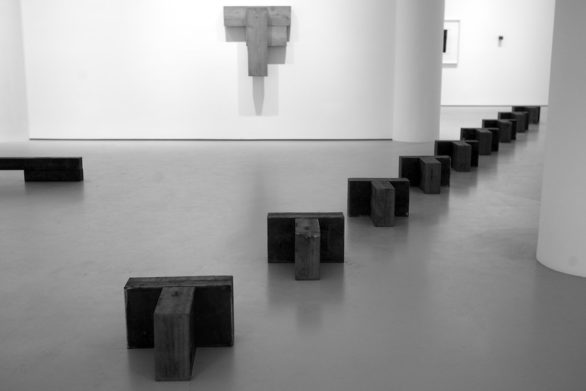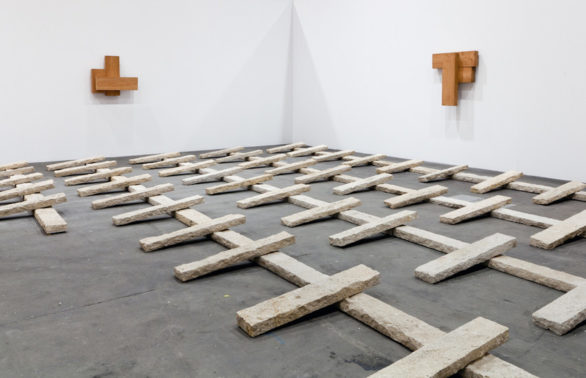
Richard Nonas
Richard Nonas: The Man in the Empty Space
First large-scale East Coast museum exhibition since 1985
The powerful sculpture of artist Richard Nonas transforms MASS MoCA’s largest gallery in a monumental exhibition that features both a survey of past works and a new site-specific commission for some 15,000 sq. ft. of space. The exhibition, the artist’s first East Coast museum show in thirty years, opened on February 13, 2016.
For five decades, Nonas has created work whose terse, reduced vocabulary belies its power to fundamentally alter our sense of landscape and architecture. His totemic sculptures — made from earthy and industrial materials that take on a timeless character and transcend their historical associations (wooden railroad ties, granite curbstones, massive boulders, thick steel plates) — have reimagined space and terrain all over the world. With horizontally oriented, ground-based works and wall-mounted pieces executed in a wide range of dimensions and weights, Nonas uses an array of serialized forms that both command and alter their environments, while retaining an intimate, human scale.
At MASS MoCA, Nonas creates a major new work for the museum’s metal-trussed, window-lined space. Titled Single Artificer, the work features 52 weathered railroad ties arranged in an expansive curve that extends diagonally from one end of the gallery to another. In addition, three massive granite chairs weighing over 3,000 pounds each — along with three accompanying stools — punctuate the space, while a selection of small wood sculptures hold the walls. Framed as a single installation, Nonas has titled the complete room No Water In. Two adjacent galleries, including the balcony that overlooks the main space, display a selection of works in wood and steel that date from the ’70s to the present. The galleries and the constellation of works within are also titled as if a single work, or, in the artist’s words, a single place. The monumental exhibition brings well-deserved attention to Nonas’ lifelong practice and his continuing influence on a younger generation of artists today.
MASS MoCA’s former factory spaces are a fitting venue for the artist who has been drawn to raw industrial buildings since his early career in the 1970s when he and peers Alanna Heiss, Alan Saret, and Gordon Matta-Clark presented exhibitions in otherwise unexpected and abandoned spaces in New York. The notion of place, and place-making, is central to Nonas’ practice, harking back to his first projects at SoHo’s groundbreaking, artist-run alternative space, 112 Greene Street. The former warehouse was a liberating laboratory for works that rejected the constraints of the commercial art world. Many of the projects created there were interventions into the building. In an interview for a recent book about 112 Greene Street’s early years by Jessamyn Fiore, Nonas explained that the most successful shows engaged the space and could only have been done in that space, a familiar refrain for many MASS MoCA exhibitions.
This attentiveness to the interplay between his work and the place where his work is located, and the new place his work creates, has defined Nonas’ approach to art-making for 50 years — in both indoor and outdoor projects — and will be evident in his treatment of the museum’s formidable gallery.
Nonas turned to sculpture in the mid-1960s at age 30, after working for 10 years as an anthropologist. His fieldwork was in northern Ontario and the Yukon Territory in Canada, and in northern Mexico and southern Arizona. Speaking about the effect that his work as an anthropologist has had on his sculptures and their function as “place-makers,” Nonas explains,
“I lived in a village of 50 people in a desert in Mexico. Over the two years I was there, I grew to understand that metaphor was central to the way the villagers held their thoughts together. And also crucial to how they understood place. When they walked through the desert, it was as if they were walking through a series of separate rooms, but there were no visual borders that I could see. They mapped the desert with mythology and memories — events that occurred at a particular site ([such as] where someone’s grandfather fell off his horse and broke a leg). What I realized is that place is defined as much by meaning as architecture.”
For Nonas, sculpture articulates that meaning more directly, more viscerally than language. “The job of art,” he says, “is to convey what language cannot.” His work evokes places and experiences that defy description and that cannot be translated into text. His forms, often arranged in pairs, series, grids, or combinations that create a dialogue and tension between them, also resist simple explanation. Though they emanate powerfully, the works remain open and shifting — both visually as viewers walk around and through them — and in meaning and association — balancing on the edge between one thing and another. Embracing ambiguity, they also fluctuate between object and place.
While Nonas always alters his exhibition sites through the placement and orientation of his work, he is attracted to environments that already have a strong inherent presence — from the thousand-year-old, recently abandoned town of Vière in the foothills of the French Alps where he created an installation last year, to MASS MoCA’s former industrial complex. Through his installations, Nonas seeks to magnify, recapture, and redirect the power and sense of place that his sites already possess. Says the artist, “I make objects that create places.”

Richard Nonas at Fergus McCaffrey, 2014, installation view.
~~~~~~~~~~~~~~~~~~~~~~~~~~~~~~~~~~~~~~
Richard Nonas
Richard Nonas was born in New York, NY, in 1936. He studied literature and then social anthropology at the University of Michigan, Lafayette College, Columbia University, and the University of North Carolina. He practiced as an anthropologist for 10 years, teaching at Queens College and doing field research on the native peoples of northern Canada, Mexico, and Arizona. At age 30, he moved to Paris to devote himself to making sculpture, before eventually returning to New York. His work was collected early on by Dorothy and Herbert Vogel and Count Giuseppe Panza di Biumo, and his sculptures are permanently installed in the stables at the Villa Panza in Varese, Italy. Nonas’ solo and two-person exhibitions include Cross Cuts: Richard Nonas and Joel Shapiro at the Knockdown Center, Queens, NY (2014); The Raw Edge: Vière et les Moyennes Montagnes, Digne-les-Bains, France (2012); Shoots Good Not Straight, Musée d’art de Saint-Etienne, France (2010); Smoke, OMI, Ghent, NY (2009); Musée d’Art Moderne et Contemporain, Geneva, Switzerland (1998); Hip and Spine (Stone Chair Setting), Josephine F. Ford Sculpture Garden in collaboration with the Detroit Institute of Arts, MI (1997, permanent); Museum of Contemporary Art Stockade, Los Angeles, CA (1993); Lucifer Landing (Real Snake in an Imaginary Garden), Cranbrook Art Museum, Bloomfield Hills, MI (1989, permanent); Lund Museum of Art, Lund, Sweden (1988, permanent); and Viewpoints: Richard Nonas, Walker Art Center, Minneapolis, MN (1978). Among other significant group exhibitions, he was included in the Whitney Biennial, New York, in 1973, as well as PS1’s inaugural exhibition, Rooms, in Queens, NY (1976), and Documenta 6, Kassel, Germany (1977). The artist has numerous permanent, public installations around the world. Nonas lives and works in New York.
Sponsorship
This exhibition is supported by the Massachusetts Cultural Council and Francis Greenburger and Isabelle Autones.


Richard Nonas at Fergus McCaffrey, 2014, installation view.

Installation view of Richard Nonas at Art Unlimited, 2014. © Richard Nonas; Courtesy of Fergus McCaffrey, New York / St. Barth

Installation view of Richard Nonas at Fergus McCaffrey, New York, 2014. © Richard Nonas; Courtesy of Fergus McCaffrey, New York / St. Barth.
~~~~~~~~~~~~~~~~~~~~~~~~~~~~~~~~~~~~~~~~~~~~~~
MASS MoCA is one of the world’s liveliest (and largest) centers for making and enjoying today’s most important art, music, dance, theater, film, and video. Hundreds of works of visual and performing art have been created on its 19th-century factory campus during fabrication and rehearsal residencies, making MASS MoCA among the most productive sites in the country for the creation and presentation of new art. More platform than box, MASS MoCA strives to bring to its audiences art experiences that are fresh, engaging, and transformative.
MASS MoCA’s galleries are open 11am to 5pm every day except Tuesdays through spring 2016. The Hall Art Foundation’s Anselm Kiefer exhibition is seasonal and reopens April 30, 2016. Gallery admission is $18 for adults, $16 for veterans and seniors, $12 for students, $8 for children 6 to 16, and free for children 5 and under. Members are admitted free year-round. For additional information, call 413.662.2111 x1 or visit massmoca.org.
www.massmoca.org
_____________________________________________________________________
